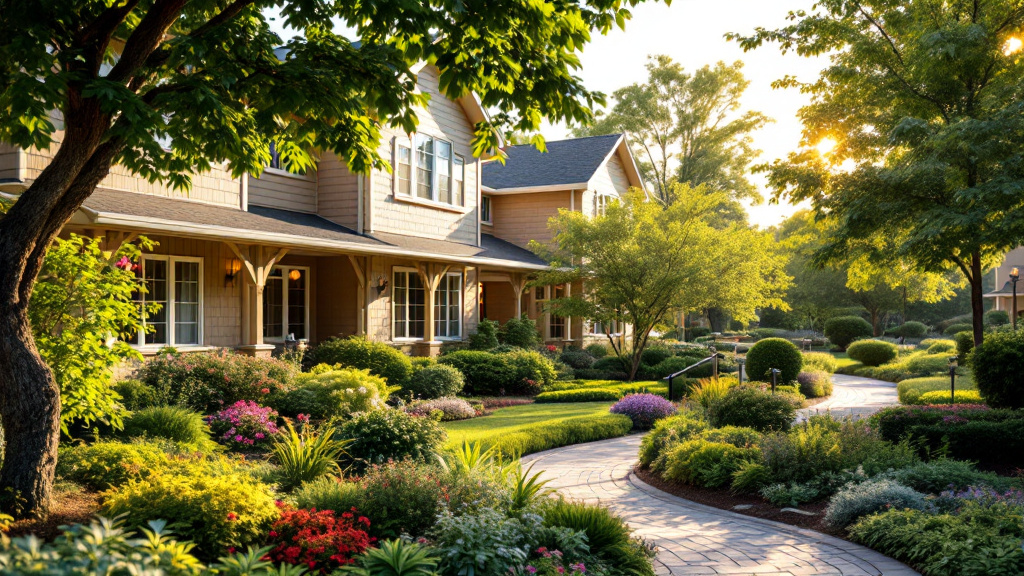How Assisted Living Encourages Hobbies and Interests for Seniors

Exploring the Role of Hobbies in Assisted Living
Assisted living facilities are not just about providing a safe and supportive environment for seniors to live; they play a significant role in enriching their lives by encouraging hobbies and interests. This not only enhances seniors' physical and mental well-being but also greatly enriches their social lives. As America's senior population continues to grow, understanding these measures becomes increasingly vital. In this article, we delve into how these facilities inspire engagement in seniors' favorite pastimes and the profound impact it has on their quality of life.
Promoting Pursuit of Passion Projects

Artistic and Creative Hobbies for Seniors
Engaging in artistic pursuits can be incredibly fulfilling for seniors. Painting not only allows for creative expression but also fosters a sense of accomplishment when the final works are displayed.
Similarly, knitting is popular among many seniors, offering therapeutic benefits and providing opportunities for social interaction in groups. Scrapbooking serves as another meaningful outlet, allowing seniors to document their memories in a tangible way, whether through traditional methods or digital platforms.
Mental and Emotional Benefits of Hobbies
Hobbies do more than fill free time; they contribute significantly to seniors' mental health. Engaging in stimulating activities like games and puzzles helps keep cognitive functions sharp, reducing the risk of dementia and enhancing memory.
Furthermore, activities that provide a sense of purpose, such as gardening or teaching skills to others, boost self-esteem and emotional well-being. This engagement combats feelings of isolation, helping seniors establish stronger connections with their peers and family.
Facilitating Hobbies Through Tailored Activities
Assisted living facilities are designed to nurture various interests through tailored activities that address residents’ preferences and abilities. Facilities often organize group exercise classes, arts and crafts sessions, and game nights to promote social interaction and creativity.
Seniors are encouraged to share their expertise and hobbies, which not only enhances community bonds but also contributes to a vibrant living environment. Recognizing personal interests and involving families in activities adds layers of connection that benefit everyone's well-being.
The Role of Hobbies in Healthy Aging

Why are hobbies important for seniors?
Hobbies are vital for seniors as they encourage an active lifestyle, which can significantly help in minimizing health risks. Activities that keep seniors engaged—like painting, gardening, or participating in book clubs—are linked to lower chances of developing dementia, heart disease, and stroke.
Participating in enjoyable hobbies, such as knitting or scrapbooking, not only combats loneliness but also reduces symptoms of depression and anxiety. Seniors engaging in meaningful activities often report higher happiness levels and greater life satisfaction. These pursuits give individuals a sense of purpose, which can contribute not only to improved mental health but also potentially to a longer, more fulfilling life.
Moreover, hobbies such as volunteering or learning new skills can enhance cognitive function. These activities stimulate the mind while fostering connections with others, thereby cultivating a community atmosphere that is essential for healthy aging. By offering opportunities for social and cognitive engagement, hobbies serve a crucial role in promoting overall well-being among seniors.
How do hobbies impact mental health?
Engagement in various hobbies offers substantial emotional benefits for seniors. Participation in activities like group exercises and arts and crafts encourages socialization, which is key in enhancing mental health. These interactions help reduce feelings of isolation, promoting a supportive environment that fosters emotional well-being.
Hobbies not only enhance cognitive functions but also provide seniors with significant emotional rewards by instilling a sense of accomplishment, boosting self-esteem, and nurturing creativity. This holistic approach to well-being effectively underscores the essential role that hobbies play in mental health for older adults.
How do hobbies enhance life satisfaction?
The fulfillment derived from pursuing hobbies is invaluable for seniors, contributing to their overall life satisfaction. Engaging in activities that align with their interests—whether it’s gardening or participating in community events—creates joy and nostalgia, further enhancing their quality of life.
Assisted living communities recognize the importance of diverse hobbies, tailoring activities to cater to individual preferences. This personalization ensures that seniors remain actively engaged and find meaning in their daily routines, which bolsters a positive outlook on life. In sharing interests within a community, seniors form bonds that lead to enhanced social connections, critical for fostering a vibrant, satisfying life in their later years.
| Hobby Type | Benefits | Community Connection |
|---|---|---|
| Artistic Activities | Creativity & Expression | Art classes and exhibitions |
| Outdoor Gardening | Physical Activity & Fulfillment | Group gardening projects |
| Games/Puzzles | Cognitive Stimulation | Regular game nights |
| Writing & Scrapbooking | Documentation & Reflection | Writing groups and sharing sessions |
Well-Being through Engaging Activities

How do activities in assisted living communities contribute to residents' well-being?
Activities in assisted living communities significantly enhance residents' well-being by promoting social interaction, emotional support, and physical health. These activities help reduce feelings of loneliness, depression, and anxiety, making life more fulfilling.
Engaging in social activities encourages residents to build friendships and create supportive networks. Group games, crafting sessions, and communal gardening provide opportunities for laughter and connection, which are foundational for emotional health.
Physical activities such as tai chi, yoga, and exercise classes improve overall fitness. They enhance flexibility, strength, and balance, thereby reducing the risk of falls. With multiple opportunities for physical engagement, residents maintain a sense of vitality as they age.
Mental stimulation is equally crucial in maintaining cognitive health. Hobbies like puzzles, writing, and arts and crafts challenge the brain and enhance memory, slowing cognitive decline. When residents engage in shared activities, they not only stimulate their minds but also experience a rewarding sense of purpose.
Involvement of family members in these activities further strengthens connections, providing additional emotional enrichment. Thus, activities in assisted living facilities play a vital role in enhancing the overall quality of life for seniors, supporting their physical, emotional, and cognitive health.
Activities Transforming Seniors' Lives

What are some examples of activities that enhance the quality of life for elderly residents in assisted living?
Engaging activities for seniors play a vital role in enhancing their quality of life in assisted living communities. Here are some noteworthy examples:
- Physical Activities: Regular group exercise classes, such as tai chi and yoga, improve flexibility, strength, and balance. These not only aid in physical health but also reduce the risk of falls.
- Cognitive Stimulation: Activities like book clubs and puzzles encourage critical thinking and help maintain cognitive function. They also facilitate social interactions, combating loneliness and encouraging engagement.
- Social Activities: Game nights, bingo, and community gardening foster connections among residents, allowing them to forge meaningful relationships. These interactions significantly enhance emotional well-being.
- Creative Pursuits: Art classes, writing workshops, and music sessions provide expressive outlets for seniors. Participants often find joy in sharing their creations, which boosts self-esteem and mental health.
How do local outings contribute to experience enrichment?
Local outings are an essential part of the enrichment that assisted living facilities offer. These excursions can include trips to parks, museums, or other local attractions, providing seniors with a refreshing change of scenery. Such experiences:
- Reconnect residents with the community, nurturing a sense of belonging.
- Stimulate curiosity and engagement, enhancing their overall happiness.
- Allow opportunities for socialization outside the facility, fostering new friendships and shared memories.
Variety of Activities Available
| Activity Type | Examples | Benefits |
|---|---|---|
| Physical | Yoga, tai chi, walking clubs | Improves health, enhances mobility, and reduces falls |
| Cognitive | Puzzles, book clubs, arts and crafts | Maintains cognitive function and boosts creativity |
| Social | Game nights, group outings | Fosters friendships, combats loneliness |
| Creative | Knitting, painting, writing | Encourages self-expression and emotional satisfaction |
| Event-Based | Holiday parties, themed events | Builds community spirit and creates shared memories |
By integrating diverse activities, assisted living communities ensure that residents are not only entertained but also enriched, promoting their overall well-being.
Social Engagement: Building Community and Connections

How do assisted living facilities facilitate social engagement among seniors?
Assisted living facilities support social engagement for seniors by curating a diverse range of activities that cater to varying interests and abilities. Residents can participate in programs such as:
- Gardening: Offers a chance for outdoor interaction and fosters teamwork.
- Art classes: These sessions not only nurture creativity but also encourage group creativity.
- Music and dance events: Social gatherings where residents can bond over shared interests.
- Game nights: Activities such as bingo, cards, and board games stimulate friendly competition and camaraderie.
These organized activities are essential for combating loneliness and emotional isolation. Engaging with fellow residents leads to the formation of friendships and a tighter community bond, especially among those who have lived in the facility longer.
How do these activities help mitigate loneliness among seniors?
Loneliness is a prevalent issue for many seniors, but the myriad of activities available in assisted living environments significantly reduces feelings of isolation.
- Community-building activities: Regularly scheduled events where residents share stories and partake in themed celebrations promote interactions.
- Intergenerational opportunities: Family involvement and visits from younger generations enhance relationship-building and reinforce community ties.
- Creative and therapeutic sessions: Music therapy and crafting workshops not only stimulate the mind but also foster emotional connections among participants.
What role does intergenerational and community involvement play?
Intergenerational and community involvement play a pivotal role in enriching the social experiences of seniors. Residents engage not just with peers but also with family members through:
- Community events: Senior residents can enjoy local festivals or excursions alongside family and friends, maintaining vital social links.
- Workshops and educational sessions: Many facilities leverage technology, enabling interactions across generations through online platforms,
- Shared activities: Activities designed to involve families nurture relationships, while also promoting emotional well-being and reducing feelings of loneliness.
Ultimately, these collective efforts foster a cohesive environment that enhances both mental health and the overall quality of life for seniors in assisted living.
Harnessing Hobbies for Holistic Health
As the senior population continues to expand, the role of assisted living facilities in fostering hobbies and interests grows increasingly important. Through tailored activities and social engagements, these facilities offer much more than just a place to live — they provide an enriching environment where seniors can thrive. By encouraging seniors to pursue hobbies they love, promoting socialization, and maintaining physical and cognitive health, assisted living facilities play an instrumental role in the holistic well-being of their residents. As we look to the future, the integration of these activities will be critical in ensuring a vibrant and fulfilling life for seniors everywhere.
References
- Hobbies for Seniors in Assisted Living - Raya's Paradise ...
- Assisted Living Offers Stimulating Hobbies for Seniors
- 68 Fun and Engaging Activities for Seniors in Assisted Living
- Engaging Activities For Seniors In Assisted Living: Keeping ...
- 7 Enjoyable Hobbies for Seniors in Assisted Living
- The Benefits of Socialization in Assisted Living - Eden Senior Care
- How Finding New Hobbies Can Help Seniors
- How to Motivate Seniors to Participate in Activities
- The Pros and Cons of Assisted Living for Seniors









































.jpg)







.jpg)





.jpg)
.jpg)
.jpg)
.jpg)
.jpg)
.jpg)
.jpg)
.jpg)



.jpg)

.jpg)
.jpg)
.jpg)
.jpg)


.jpg)
.jpg)
.jpg)
.jpg)

.jpg)
.jpg)
.jpg)


.jpg)
.jpg)










.jpg)
